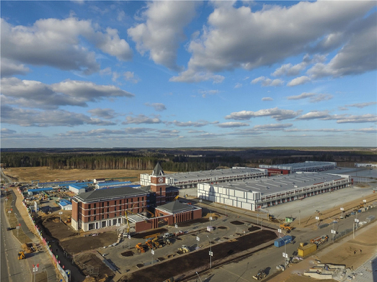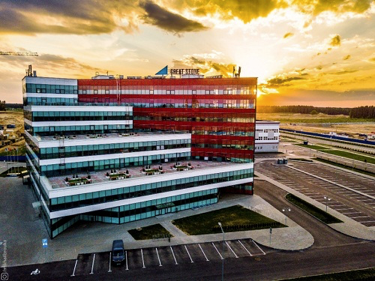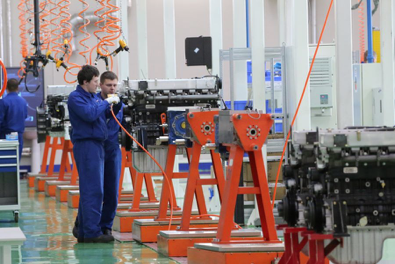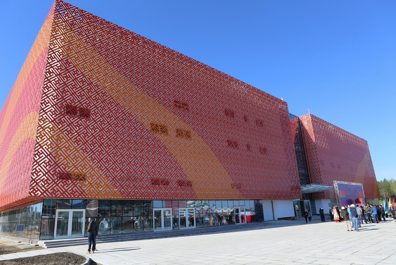Overview
The China-Belarus Industrial Park project, the largest joint project of China and Belarus, is situated in the geographical center of Europe, and viewed as a key element within the concept of new Silk Road Economic Belt.
The China-Belarus Industrial Park is a territorial entity with an area of 91.5km² and a special legal status conducive to doing business. It offers easy access to international highways, an international airport (included in the park), international railways and the capital of Belarus with its labor and scientific resources. The park’s tax preferences, free customs regime with EAEU countries, including Russia and Kazakhstan, give access to a market of about 183 million customers.

An aerial view of the China-Belarus Industrial Park. (Photo: Xinhua)
In October 2011, the governments of China and Belarus signed the agreement to set up the industrial park (it was ratified by the parties and came into force on January 30, 2012). The industrial park is a special economic zone created by both countries within the framework of the Belt and Road Initiative, and serves as a key platform for attracting worldwide high technology and investment.
The park has a three-level management structure: 1. Intergovernmental coordination council; 2. Great Stone Industrial Park Administration; 3. Great Stone Industrial Park Development Company. The Park Administration is responsible for any administrative procedures in the park, and registration of residents and the park provides “one-stop service” opportunities. The Industrial Park Development Company is responsible for the construction of infrastructure, land plot allotment and attracting investors.

13 kilometers of roads inside the China-Belarus Industrial Park. (Photo:CAMCE)
Contractors
China: China CAMC Engineering Co., Ltd. (CAMCE)
Belarus: The Ministry of Economy of the Republic of Belarus

Chinese President Xi Jinping (R) meets with Belarusian President Alexander Lukashenko, June 14, 2019. (Photo: Xinhua)
Shareholders
China National Machinery Industry Corporation (SINOMACH)
China Merchants Group(CMG)
China CAMC Engineering Co., Ltd. (CAMCE)
Harbin Investment Group Co., Ltd.
Great Stone Industrial Park Administration
Duisburger Hafen AG
Progress
In 2010, the idea was first proposed during the visit of China Vice President Xi Jinping (now President) to Belarus in March.
In 2011, the governments of Belarus and China signed the agreement to set up the industrial park.
In 2012, the Decree of the Belarusian President No. 253 on the Chinа-Belarus Industrial Park (June 5, 2012) established a special legal status for this territory.

In 2014, The official groundbreaking ceremony heralding the launch of the construction was held on June 19, 2014. The symbolic event was attended by over 50 top managers of leading companies from all over the world.
In 2015, the leaders of the two countries signed the general layout of the Great Stone, got familiar with the investment projects of the park's first residents who received their park resident licenses in a ceremony featuring the two presidents.

An office building constructed by CAMC at the China-Belarus Industrial Park in Minsk. (Photo: CAMCE)
In 2017, President's Decree No. 166 (May 12, 2017) established a wider scope of incentives and made the park's regime of doing business one of the best in the EAEU.
By the end of 2017, 43 companies were registered with the park and had signed agreements to make total investments of more than $1 billion, compared with 23 companies. Among them, 14 had already started manufacturing and providing services.

Employees assemble diesel engines in the China-Belarus Industrial Park in the Belarusian capital of Minsk. (Photo: Xinhua)
In 2018, the park was home to 36 enterprises, 20 of which are from China. Notable Chinese companies include diesel engine manufacturer Weichai, telecommunications giant Huawei, China Merchants Group, among others. The other 16 companies are from countries including Austria, Belarus, Germany, Israel, Lithuania, Russia, and the United States, making the park a truly multinational business hub.
In 2019, the China-Belarus industrial park has been granted the status of a Overview
The China-Belarus Industrial Park project, the largest joint project of China and Belarus, is situated in the geographical center of Europe, and viewed as a key element within the concept of new Silk Road Economic Belt.

The business and trade logistics park exhibition center at the China-Belarus Industrial Park in Minsk. (Photo: Xinhua)
The China-Belarus Industrial Park is a territorial entity with the area of 91.5km² with a special legal status conducive to doing business. It offers easy access to international highways, international airport (included into the territory of the Park), international railways and the capital of Belarus with its labor and scientific resources. The Park’s tax preferences, free customs regime with the EAEU countries, including Russia and Kazakhstan, give access to a market of about 183 million of customers.
Significance
The China-Belarus Industrial Park is an important BRI project. At present, China-Belarus relations of comprehensive strategic partnership, featuring mutual trust and win-win cooperation, has been developing at a high level. To accelerate the construction of the China-Belarus industrial park, seek more achievements in mutually beneficial cooperation in various fields will push forward bilateral relations to new levels.
For China, Belarus is located in the center of Europe, connecting the Eurasian Economic Union and the European Union (EU), and sharing a critical junction along the Belt and Road routes. Chinese enterprises will have opportunities to access to other countries and regions.
For Belarus, China not only sees the industrial park as an important junction with the European market, but it is also invested in Belarusian enterprises and does businesses in the country. Belarus could take advantage of these opportunities to boost its market demand because its market demand is not that big and the majority of its own products are export-oriented. Chinese enterprises would play a significant role in improving local technology levels.

Huawei offers support for local digital transformation in Minsk. (Photo: China Daily)


